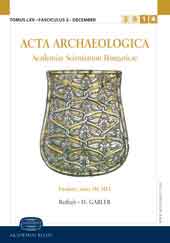Die Stellung des Typs Svodín der anthropomorphen Gefässe im Neolithikum des Donaubeckens
The place of the Svodín type anthropomorphic vessels in the Neolithic of the Danube Basin
Author(s): István Zalai-GaálSubject(s): Archaeology, Cultural history, Ancient World
Published by: Akadémiai Kiadó
Keywords: Neolithikum; Kult; Lengyel-Kultur; anthropomorphe Gefässe;
Summary/Abstract: The place of the Svodín type anthropomorphic vessels in the Neolithic of the Danube Basin. The author carried out the typological analysis of the Neolithic and Early Copper Age anthropomorphic vessels of the Danube Basin on 70 complete or reconstructed items recovered from 53 sites and found analogues as far as Anatolia. He also determined the place of the “Svodín type” anthropomorphic vessels in the large group of anthropomorphic vessels of Central and Southeast Europe. A so-called threepartite “Schultergefäß” furnished with human traits (arms/hands, plastic breasts and plastic or painted facial parts) can be regarded as the archetype of the Svodín (Szogyén, Slovakia) type anthropomorphic vessels. The vessels and the fragments that can be grouped in the type have been found on the territories of SW Slovakia and Lower Austria, at Aszód and Csabdi and also in larger numbers at a few sites of the Southern Transdanubian Lengyel culture, especially at Györe. The anthropomorphic vessels from Central and Southeast Europe entered into the database can morphologically be grouped into three forms (Gattung), eight series (Serien), 23 morphological groups and 42 versions. Basically, standing (72.3 %), sitting/enthroned (22.3 %) and hollow-pedestalled (5.2 %) vessel shapes can be differentiated. According to the analyses, vessel shapes that appeared only in the early or the middle or the late phase or only in the Aeneolithic and transitional shapes can be differentiated. The author also examines the meaning of the discussed anthropomorphic vessels, to what purpose they were made, based first of all on the finding circumstances. All the “Svodín-type” anthropomorphic vessels characteristic of the eastern occupation zone of the late Neolithic Lengyel culture came from the early phase of the culture. It could be observed that the figural plastic representations of the Lengyel culture show many similar traits to those of the Tisza culture in the Alföld, which is not surprising since the two cultures even shared a few sites on the territory of Northern Hungary. Regarding the anthropomorphic vessels, regional divergences can be discovered in the early Neolithic of Southeast Europe, which divergences increased in the subsequent periods and differences appeared between cultures and also between the individual sites.
Journal: Acta Archaeologica Academiae Scientiarum Hungaricae
- Issue Year: 60/2009
- Issue No: 1
- Page Range: 1-49
- Page Count: 49
- Language: German
- Content File-PDF

